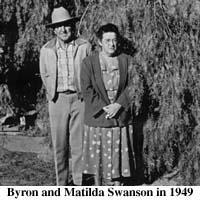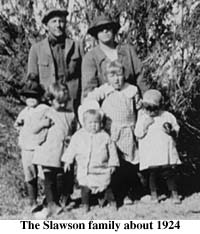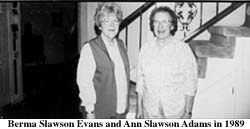Arizona School Yearbooks by County

The Slawson Family
Warner Road was a dirt trail that went straight up towards the mountain. At its end was the huge gate that offered entrance to the 2000 acre property. The Old House, which the youngsters in the area called "the castle," stood on the north side of Warner, where Sequoia Rd. now crosses beneath the power line. To the left was the smaller house occupied by Byron and Matilda Slawson and their five children.

Byron Slawson accepted the position as caretaker for Mrs. Ames in 1922, and moved his family into the three bedroom home. The last of the five children, Berma, was born in that house. The children -- Anna Marie, Robert, Delilah, Wanda and Berma -- all grew up there at Ahwatukee.
Byron Slawson was a highly respected member of the community. He was, as Tom Carney remembers, "sturdy, fun and no foolishness." He was carpenter, gardener, plumber, chauffeur; like all farmers of his day, he learned, from necessity, to do just about everything that needed doing around the house and farm. At a time when jobs were very scarce, he was most grateful to have this job with a home for his family.

Matilda Slawson was a reserved, quiet woman able to handle life in the desert. Before her marriage, she was Arizona's first woman mail carrier, making her rounds on horseback in the town of Higley. After giving birth to the five Slawson children, she suffered from a long series of brain tumors. She had to have surgery five different times and the last left her incapable of functioning for the last year of her life.
Yet, by all accounts, she was a delightful lady who taught her daughters to cook, clean and sew and to be very proper young ladies. She set certain community standards. A party or other gathering was judged on the basis of "if the Slawson girls are going, it's OK."
The Slawson girls were all "good, sweet girls who followed all the rules -- and they'd tell on you if you didn't." They developed a reputation as a good singing group. Berma had an additional talent -- she could whistle with the best of them -- even though her mother didn't consider it very ladylike.
School and Church
As in farm communities 'most anywhere in the U.S. during the '20s and '30s, life away from home centered around school and church. Ann (now Ann Adams) remembers that some of the best times were associated with school. When the children were all very young, and the school bus wouldn't come all the way out here to take them to the Kyrene School, Byron Slawson built a special cart for them to ride to school.

The cart consisted of a square open box mounted above an axle with two wheels. In the center of the box was a cut-away area and beneath it was attached half of a 50 gal. drum. The children sat in the wooden box and rested their feet in the drum. All were embarrassed to be going to school in Dad's homemade cart, only to learn later that they were the envy of the whole school.
Money was scarce in those days, and the young people learned to make their own fun. The school May Day celebration with three May poles was great fun -- winding all those colored ribbons around the poles. There was usually "one ornery boy who would take his ribbon the wrong way to mess it up on purpose."
The last day of school was a day they all still remember well. Everyone in town came for the morning graduation ceremony and the "potluck picnic pig-out" to follow. There was always a fathers-and-sons baseball game. Many happy memories came from those day-long end-of-school festivities.
In addition to school functions, the church was also a center of activity. Mrs. Slawson was instrumental in getting the Sunday School started at Kyrene Community Church. Both the Slawsons were active Christians and the Slawson daughters became Sunday School teachers as soon as they were old enough to help. The young people usually came out to the ranch to have their barbecues, potluck parties, volleyball games or hikes. Hazel Owens says, "I didn't know why they always had us all there at the house, but I know now -- so they could keep an eye on us!"
Holidays
Christmas and Easter were times full of warm memories for the Slawson children. While Mrs. Ames still owned the ranch, she helped make these holidays special for the youngsters.
At Easter she gave a party at school for the 1st and 2nd graders, and she had Easter eggs and candy for all the children. The high point of Easter Sunday was the Sunrise Service held on the hill behind the Slawson house. Everyone rode horseback up to the service and had breakfast together afterwards.
The Christmas season was especially bright because of Mrs. Ames' efforts. She gave a party in her home each year for all the Slawson children and their friends. The children came to "the castle" on the school bus, and were ushered inside for a Christmas party. Everyone had hot chocolate "in fancy mugs." In the large room with the fireplace were three tables, all laden with gifts wrapped in brightly colored Christmas paper. Each boy and girl left the party with his/her own gift.
The Ahwatukee house took on a special magic at Christmas. The huge tower-like chimney rose high above the housetop, and the Slawson children were sure that Santa lived there. Berma even saw him emerge through the doorway at the base of the chimney one year carrying his pack on his back. These were wonderful years on the ranch, considering that the nation as a whole was in the throes of a depression.
Mrs. Ames and Miss Brinton
While the Slawson children were growing up, their father was employed by Mrs. Ames until her death and then by Miss Brinton who bought Ahwatukee in 1933. Ownership of the house was about all the two women had in common, because they were totally different in every other way.
There was even a bit of friction between the two women while Mrs. Ames still lived. Miss Brinton had bought a section of land bordering on the Ahwatukee Ranch. Located at what is now 48th & Ray, it was called "the patch." Miss Brinton wanted to buy land from Mrs. Ames' property, but Mrs. Ames refused to sell any of it.
There is no doubt about how the Slawson offspring remember Mrs. Ames. She was a warm, grandmotherly little lady who loved children. The parties mentioned above are evidence of her care for the children.
She loved to ride her horses, and she rode often. Still riding at age 77, she insisted that Byron Slawson accompany her on her rides.
All the children remember good times at Mrs. Ames' large home. They felt at home there and were allowed to use the facilities. Their favorite spot was the rooftop garden located above the dining room. Up there they could sit and look out on the entire Valley.
Just before her death, Mrs. Ames suffered with stomach cancer, and was in a great deal of pain. In an effort to find some relief, she summoned Swami Yogananda. He taught her meditation techniques and prescribed a change in diet, recommending Middle Eastern curried foods. She apparently found some relief using his methods. The Swami's arrival, in his turban and flowing robes, created quite a stir in the quiet, Christian community. He was definitely regarded as an intruder.
At her death, Mrs. Ames left her home and property to St. Luke's Hospital, and they, in turn, sold it to Miss Brinton.
In contrast to Mrs. Ames, Miss Brinton did little to endear herself to the Slawsons or other residents of the area. She wanted no one around and quite emphatically believed that "children should be seen and not heard," though she obviously preferred not to see them either.
Robert Slawson, the only son in the family, acquired a Harley Davidson motorcycle when he was a teenager. When Miss Brinton heard him start the cycle, she became livid. She ordered Bob to walk his cycle down Warner Road and start it only after he was out of earshot.
Ann, the oldest Slawson daughter, spent more time with Miss Brinton than any of the children. She spent one entire summer working in her summer home in Wyoming as a maid. Miss Brinton always remained quite stand-offish.
Miss Brinton's most generous act towards the Slawsons came at her death. She had a provision in her will that gave lifetime tenancy to Byron Slawson. He had the right to occupy their little home and 40 acres of land for as long as he lived. He needed only to keep the taxes paid on it. Others advised him to try to gain outright ownership, but he respected Miss Brinton's wishes and never contested the will. He was a man of extreme integrity and was grateful to have a home in which to live.
Life on the Ranch
Life was not easy on the ranch -- there was plenty of hard work for everyone. Byron Slawson's job was 24-hours-a-day, and all the kids were expected to pitch in and do their part. Ann, as the oldest, helped with the care of the household and her younger siblings because Mother was often not feeling well. All the kids helped Dad mend fences, clean out corrals, and water the cacti and orange groves.
Because space was limited in their little home, the children slept outdoors year-round until Miss Brinton ordered construction of a screened porch at one end of the house. The porch then became their sleeping area.
Ann and brother, Bob, raised pigeons in the cattle stalls behind the Slawson home. When Mrs. Ames was in a mood for squab, she would buy the needed birds from the youngsters. Ann remembers getting $5 for each pigeon, a price that seemed astronomical to a couple of young, enterprising business people.
The desert around the ranch was raw and wild then. Every summer the Slawsons killed 15-30 rattlesnakes. One summer the kill totalled 45. The younger Slawsons learned to skin the snakes and use the hides for belts and hat bands. Berma remembers the time she was cleaning a dead snake. As she ran the knife along the belly, a bunch of baby snakes came slithering out. She never skinned another snake again.
Scorpions abounded everywhere, and all the Slawson children were bitten by a scorpion at one time or another.
The mountains behind the ranch were full of coyote caves, and every year a coyote had her pups in the canyon behind their house near Hieroglyphic Rock.
The land may have been wild, but it was beautiful, too. The kids loved to spend time in places like Fat Man's Pass and Guadalupe Pass. Hieroglyphic Canyon was a favorite spot. Water accumulated there and pools could be found about nine months out of the year. Sheep from neighboring pastures used to wander in there, "smelling" the water.
Several rock slides in the canyon had water tumbling down their sheer faces during the rainy season. It was a great place for teenage boys and girls to ride their horses and picnic.
The Ahwatukee Ranch, as Tom Carney recalled, was "a busy, happy place where no one ever wondered what they were here for. We were all in the same boat, trying to make a living and keep the weeds down."
Within the struggling farm community, the Slawsons were fondly remembered as busy, active people who cared about their fellow man. They were involved with the PTA and the church, and did their part to help the young people of the community grow to be upstanding citizens.
The Later Years
Ahwatukee, "the house of our dreams," stood for over 50 years. Its life span extended from the days of kindly Mrs. Ames, through the reclusive, distant lifestyle of Miss Brinton. There was even a period in the '60s when the house was occupied by a group of hippies, some of whom were college students at ASU.
Through all this, Byron Slawson maintained his residence in the little house. He lived there from 1922 to 1975. He built the Ames trail into Hidden Valley, and, at Miss Brinton's direction, designed, planted and maintained the gardens around the house. His mark on the property was unmistakable. It was with a great deal of difficulty that he watched when the big, old house he'd cared for was torn down.

Ann Slawson Adams returned to live in the Slawson family home and help care for her father in 1972. She remained there until 1979. With the community spirit she'd learned while growing up on the Ahwatukee Ranch, she directed the disposal of the properties.
When the main house was torn down, she screened people coming in for lumber. Bits and pieces of that magnificent home are still in homes in Guadalupe. She also donated the 25-cycle electrical equipment from the house to the SRP museum.
It was a highly emotional day when the Slawson home came down. More than a few tears were shed. A lot of living, loving and growing had taken place in that house.
Byron and Matilda Slawson spent all their adult lives working to make the Ahwatukee ranch a good place to live. They're gone now, but their legacy lives on in the lives of their children and grandchildren. Their love for God, care for a neighbor, and concern for the welfare of the community endeared them to the whole generation that grew up in and around Ahwatukee Ranch.
We want to express gratitude to the folks who have shared their memories and given their time to make this article possible--Ann Slawson Adams, Berma Slawson Evans, Tom and Hazel Owens and Tom Carney.





